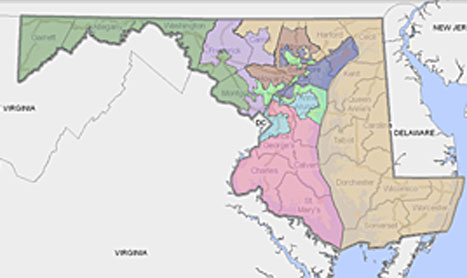ANNAPOLIS — Days into the 2016 legislative session, Republican Gov. Larry Hogan named redistricting reform as one of his top priorities, saying that Maryland is one of the most gerrymandered states in the country.
Thursday, his bill to accomplish that goal was scrutinized by the Senate Education, Health, and Environmental Affairs Committee.
The bill, sponsored by House and Senate leadership, at the request of the governor, requires an amendment to the Maryland Constitution and the creation of a commission to draw up new General Assembly and Congressional districts.
General Assembly districts would be equally divided among population, with no more than a 2 percent change in population in any district, under the bill.
The legislation also emphasizes geography. Congressional districts would be contiguous and take into account the boundaries of cities and counties.
This is likely in response to Maryland’s 3rd Congressional District, which was nicknamed the “praying mantis” district by the Washington Post, and has also been said to resemble a “broken-winged pterodactyl, lying prostrate across the center of the state,” by a federal judge.

The 3rd District, which covers parts of Baltimore, Baltimore County, Howard, Montgomery and Anne Arundel, has been called one of the most gerrymandered districts in the country.
“We have a chance to take Maryland from the worst state in this to the best, let’s not miss it,” said Walter Olson, co-chair of the redistricting commission and a senior fellow with the Cato Institute.
The proposed commission is supposed to be independent from politics in the General Assembly, composed of three members from each major party and three members that are not registered with either. Members wouldn’t be allowed to hold office, work for the General Assembly or register as a lobbyist.
“For too long, fair elections and a healthy, strong, and competitive two-party system have been nearly impossible in our state,” Hogan said in a press release when the legislation was announced in January. “This is about recognizing a problem and choosing to do the right thing to solve it.”
The legislation mandates that after each decennial census, the commission would draw a map of districts, along with a report to justify them, and give the maps to the Maryland Secretary of State, who would certify them and send them to the General Assembly. If the legislature approves the maps with a three-fifths majority, they would go to the Governor for signature or veto under the bill.
Ashley Oleson, administrator for the League of Women Voters of Maryland, praised the proposal, saying that it takes into account the wishes of voters who want to take redistricting decisions out of the hands of legislators.
Oleson, who sat on the commission that recommended the bill, said it was “critical to good governance” because it makes the process transparent and will create more representative districts.
The federal government leaves it up to the states to draw their own districts every 10 years, after the census, as long as they don’t violate the Voting Rights Act of 1965 or other federal laws.
Currently, the governor can propose his own map for congressional and state districts, and the General Assembly can put forth its own proposal as well. After the last census in 2010, Democrats drew up the current district lines, including the widely criticized 3rd District.
If this measure passes, Maryland would join Arizona, California, Hawaii, Idaho, Montana, New Jersey, and Washington as states that use an independent commission to redraw districts.
Thursday’s committee hearing is just one step in a long road to passage for Hogan’s bill. If it passes in both chambers of the Democrat-controlled General Assembly, it would appear on the ballot in November 2016, and pass if it gets a simple majority.
The focus on election districts in Maryland isn’t new. Hogan talked about changing the redistricting process during his campaign in 2014.
In August, he created an 11-member Redistricting Reform Commission by executive order. The current legislation came from their recommendations.
Democrats agree that redistricting reform needs to happen, but disagree on how to accomplish it.
Sen. Joan Carter Conway, D-Baltimore, sits on the redistricting commission, as well as the Education, Health and Environmental Affairs Committee. She opposes the plan suggested by the commission because, she said, she did not see a lot of input from Hispanic and black constituents.
“The individuals whose hue and cry are coming for redistricting are not a diverse group of individuals,” Conway said.
She is also sponsoring a joint resolution with the House of Delegates, asking Congress to act on redistricting reform. She said that the resolution is not in response to Hogan’s proposed plan.
That has been the approach of other top Democrats as well. Senate President Thomas V. “Mike” Miller Jr. has said that he wanted to wait for national redistricting reform before he acted on it in Maryland. He had no comment on the bill Thursday.
“Congress has had bills in front of it for a long time that could fix this for every state, and they don’t pass it,” said Sen. Ronald Young, D-Frederick and Washington. “I commend what you’re trying to do (by proposing an independent commission), but I think we should do it when everyone else does it.”
Proponents of the bill say that the state can’t wait for Congress to act on what they say is an urgent problem for Maryland voters.


You must be logged in to post a comment.